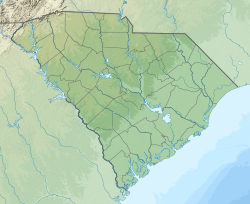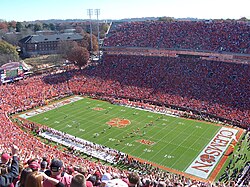"Death Valley" | |
 Memorial Stadium in 2013 | |
| Former names | Memorial Stadium (1942–1974) |
|---|---|
| Address | Avenue of Champions |
| Location | Clemson, South Carolina |
| Coordinates | 34°40′43″N82°50′35″W / 34.67861°N 82.84306°W |
| Operator | Clemson University |
| Capacity | 81,500 (2007–present) Former capacity List
|
| Record attendance | 86,092 (Clemson Tigers v Florida State) (1999) |
| Surface | Tifway 419 Bermuda Grass |
| Construction | |
| Broke ground | October 6, 1941 [1] |
| Opened | September 19, 1942 |
| Expanded | 1958, 1960, 1978, 1982, 1983, 2006, 2022 |
| Construction cost | $125,000 (original stadium) ($2.89 million in 2024 dollars [2] ) |
| Architect | Carl Lee and Professor H.E. Glenn |
| General contractor | A.N. Cameron and Hugh Webb [3] |
| Tenants | |
| Clemson Tigers (NCAA) (1942–present) Carolina Panthers (NFL) (1995) | |
| Website | |
| clemsontigers.com/memorial-stadium | |
Frank Howard Field at Memorial Stadium, known as "Death Valley", is an outdoor stadium on the campus of Clemson University nearClemson, South Carolina. It is home to the Clemson Tigers football team of the Atlantic Coast Conference (ACC).
Contents
- History
- Construction
- Scroll of Honor
- Death Valley
- Death Valley facts
- Notable games
- Traditions
- Howard's Rock
- Running Down the Hill
- Gallery
- See also
- References
- External links
Built between 1941–1942, the stadium was originally named Memorial Stadium in memory of "all Clemson men who have made the supreme sacrifice for their country." [4] In 1974, when legendary, long-time head coach and athletic director Frank Howard retired from the university, it was announced that the playing surface would be named in his honor.
The stadium has seen expansions throughout the years with the most recent being the WestZone with Phase 1 construction beginning in 2004 and completing in 2015 with the addition of the Oculus, the final piece of Phase 3. Phase 1 of the EastZone project began in 2020.
Prior to the completion of Bank of America Stadium, in Charlotte, Memorial Stadium served as the home venue for the National Football League (NFL)'s Carolina Panthers during the team's inaugural 1995 season.
Currently, the stadium is the largest in the ACC.










